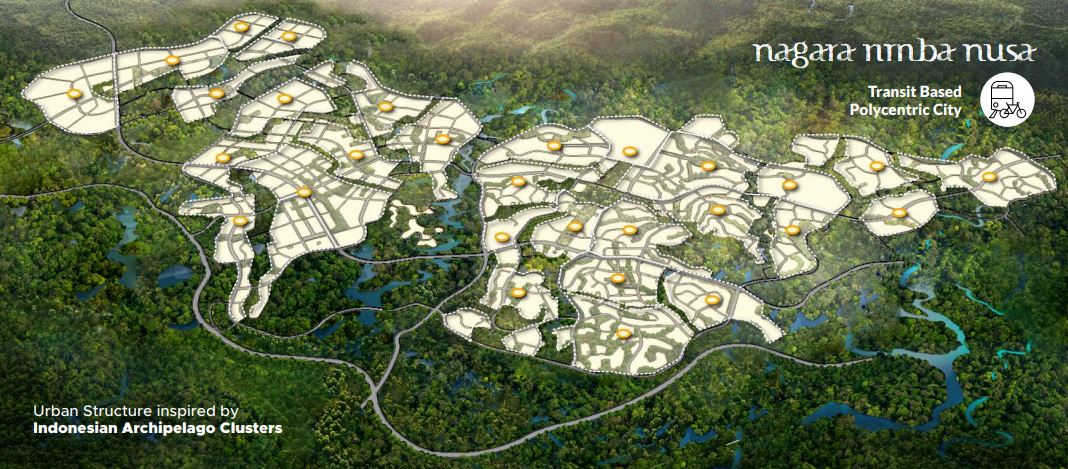New Direction in the Culturally Inspired Urban Forms of Indonesia’s New Capital City of Nusantara
Main Article Content
Abstract
The plan to relocate Indonesia’s capital to Nusantara, Penajam Paser, Kalimantan Timur is a big leap in Indonesian history. Nusantara is visioned to represent Indonesia’s identity; establish social, economic, and environmental sustainability; and create a smart, modern, and international standard city (Smart Metropolis). Situated in the equator zone, Kalimantan Island, known also as Borneo, has a rain forest ecosystem with great biodiversity. Therefore, the relocation has sparked debate on deforestation in Borneo. From the contrary perspective, the existing environment of Nusantara is seen as an opportunity for Indonesia to forge an extraordinary example of city development that brings together nature and city as one ecosystem by rooting to Indonesia’s nature and cultural heritage, and by adopting advanced smart technology as enablers to create a city for the future. Nusantara is designed to respect and emulate the wisdom enshrined in the forests and culture of Indonesia. The axis principle of mountains and ocean in traditional Indonesian cosmology is used to create the city’s underlying structure. The tradition of stilt houses, the concept of veranda in tropical buildings, and provision of arcades for street vendors have been incorporated in the design in modern forms. This article describes the strategies and concepts underlying this new capital city of Nusantara.
Article Details
References
BBC News. 2019. “Indonesia Picks Borneo Island as Site of New Capital.” BBC, August 26. https://www.bbc.com/news/world-asia-49470258.
Beranda. 2023. “Rumah Adat Karo.” https://ruangarsitek.id/rumah-adat-karo/
Burton, Elizabeth, Mike Jenks, and Katie Williams, eds. 1996. The Compact City: A Sustainable Urban Form? London: Routledge.
Chepkemoi, Joyce. 2017. “Which Are the Island Countries of the World?” WorldAtlas, April 25. https://web.archive.org/web/20171207094959/http://www.worldatlas.com/articles/which-are- the-island-countries-of-the-world.html.
Evers, Hans-Dieter. 2016. “Nusantara: History of a Concept”. Journal of the Malaysian Branch of the Royal Asiatic Society 89 (1): 3-14. doi:10.1353/ras.2016.0004.
Gaveau, David L. A., Douglas Sheil, Husnayaen, Mohammad A. Salim, Sanjiwana Arjasakusuma, Marc Ancrenaz, Pablo Pacheco, and Erik Meijaard. 2016. “Rapid Conversions and Avoided Deforestation: Examining Four Decades of Industrial Plantation Expansion In Borneo”. Scientific Reports 6 (1). doi:10.1038/srep32017.
Ghisleni, Camilla. 2020. “What Is Biomimetic Architecture?”. ArchDaily, December 31. https://www.archdaily.com/954004/what-is-biomimetic- architecture#:~:text=Biomimetic%20architecture%20is%20a%20multi,in%20natural%20enviro nments%20and%20species.
Hairah, Ummul, Andi Tejawati, Edy Budiman, and Fahrul Agus. 2017. “Borneo Biodiversity: Exploring Endemic Tree Species and Wood Characteristics”. 2017 3Rd International Conference on Science In Information Technology (Icsitech). doi:10.1109/icsitech.2017.8257152.
Humas Setneg. 2019. “Presiden: Pindah Ibu Kota Bukan Sekadar Pindah Kantor Pemerintahan.” Setneg.go.id, December 17. https://www.setneg.go.id/baca/index/presiden_pindah_ibu_kota_bukan_sekadar_pindah_kantor_pemerintahan
Indonesia Tourist Forum. 2014. “The Daily Life of Dayak Tribe.” https://www.indonesia-tourism.com/forum/showthread.php?46791-The-Daily-Life-of-Dayak-Tribe
Kellert, Stephen R., and Elizabeth F. Calabrese. 2015. “The Practice of Biophilic Design.” Biophilic. https://www.biophilic-design.com/.
Kikimunai. 2020. “Rumah Adat Tongkonan.” https://kikomunal-indonesia.dgip.go.id/index.php/jenis/1/ekspresi-budaya-tradisional/29267/rumah-adat-tongkonan
Kusno, Abidin. 2020. Reposisi Nusantara. Jakarta: RAW Press.
Lechner, Alex, and Sofian Sibarani. 2022. “New Capital City – A Model for Sustainable Urban Transformation?”. The Jakarta Post. https://www.thejakartapost.com/paper/2022/04/27/new- capital-city-a-model-for-sustainable-urban-transformation.html.
Lyons, Kate. 2019. “Why Is Indonesia Moving Its Capital City? Everything You Need to Know.” The Guardian. Guardian News and Media, August 27. https://www.theguardian.com/world/2019/aug/27/why-is-indonesia-moving-its-capital-city-everything-you-need-to-know.
Mackinnon, Kathy, Gusti Hatta, Arthur Mangalik, and Hakimah Halim. 1997. The Ecology of Kalimantan. 3rd ed. Oxford: Oxford University Press.
Metusala, Destario, Fauziah, Dewi Ayu Lestari, Janis Damaiyani, Shofiyatul Mas’udah, and Hari Setyawan. 2020. “The Identification of Plant Reliefs in the Lalitavistara Story of Borobudur Temple, Central Java, Indonesia”. Biodiversitas Journal of Biological Diversity 21 (5). doi:10.13057/biodiv/d210549.
Moreno, Carlos, Zaheer Allam, Didier Chabaud, Catherine Gall, and Florent Pratlong. 2021. “Introducing The “15-Minute City”: Sustainability, Resilience and Place Identity in Future Post-Pandemic Cities”. Smart Cities 4 (1): 93-111. doi:10.3390/smartcities4010006.
Muhtadi, Burhanuddin. 2022. “Analysing Public Opinion on Moving Indonesia’s Capital: Demographic and Attitudinal Trends.” FULCRUM, May 31. https://fulcrum.sg/analysing-public- opinion-on-moving-indonesias-capital-demographic-and-attitudinal-trends/.
Nas, P.J.M. 1989. “Town and Countryside in Indonesia: A Sceptic’s View”. Journal of Social Issues in Southeast Asia 4 (1): 20-33. doi:10.1355/sj4-1c.
Pawlyn, Michael. 2016. Biomimicry in Architecture. Second ed. London: RIBA Publishing.
Portal Informasi Indonesia. 2019. “Rumah Betang Tak Hanya Kediaman Suku Dayak.” https://indonesia.go.id/ragam/budaya/kebudayaan/rumah-betang-tak-hanya-kediaman-suku-dayak
Prie, Mitu M. 2014. Pancaran Limasan (The Brilliance of Limasan). Jakarta: Red & White Publishing.
Silver, Christopher. 2008. Planning the Megacity: Jakarta in the Twentieth Century. New York: Routledge.
Tzonis, Alexander, Bruno Stagno, and Liane Lefaivre. 2001. Tropical Architecture. Chichester: Wiley-Academic.
United Nations. 2018. “World Urbanization Prospects 2018.” United Nations. https://population.un.org/wup/.
World Bank. 2022. “Indonesia Overview.” April 5. https://www.worldbank.org/en/country/indonesia/overview.
Yeang, Ken. 1987. Tropical Urban Regionalism, Building In A South East Asian City. Singapore: Concept Media.


